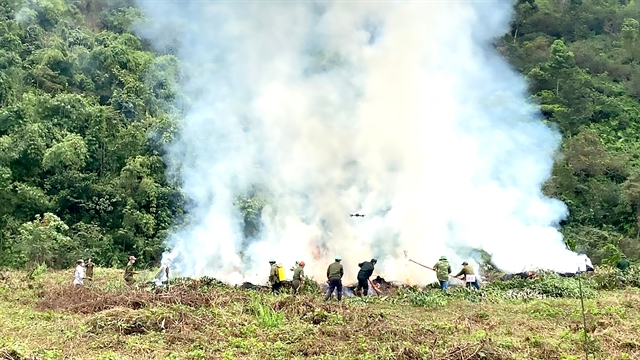 Society
Society

 |
| Panelists at the air pollution and the transport sector session on December 5 in Hà Nội. — Photo courtesy of the organiser |
HÀ NỘI — Leading experts discussed sustainable transportation solutions and the role of science in improving air quality in large cities at a symposium on December 5.
The event, entitled Air Pollution and the Transportation Sector: Opportunities and Challenges in Việt Nam and Elsewhere, is part of a series of Science for Life symposia within the framework of the 2024 VinFuture Sci-Tech Week.
At the event, speakers discussed many topics, including the causes of air pollution in large cities; and the role of electric vehicles in transforming the transport industry and improving air quality.
New findings and experiences in controlling pollution in large cities will help Việt Nam improve urban air quality and develop more effective transportation and environmental strategies.
 |
| Associate Professor Hồ Quốc Bằng, Hồ Chí Minh City National University at the event. — Photo courtesy of the organiser |
Speaking at the event, Associate Prof. Hồ Quốc Bằng, Hồ Chí Minh City National University, said that air pollution in large cities like Hà Nội and HCM City came mainly from traffic, industrial production and fossil fuel use.
In Hà Nội, there are about 8.5 million people (in 2022), more than 6.1 million motorbikes, about 700 thousand cars and nearly 2,000 factories with emissions. Road traffic activities emit gases such as NOx (87 per cent), CO (92 per cent), SO2 (57 per cent), NMVOC (86 per cent), CH4 (96 per cent) and PM2.5 (74 per cent). Industrial production activities contribute 39 per cent of SO2 in Hà Nội's total emissions.
Similarly, in HCM City, with a population of more than 9 million people and 7.4 million motorbikes, emissions from traffic account for a high proportion, especially CO (97.8 per cent), PM2.5 (18 per cent) and NOx.
These numbers show the severity of air pollution in large cities in Việt Nam and the need for solutions to control and reduce emissions, according to Prof. Bằng.
In addition, Prof. Bằng added that Việt Nam also faces challenges from other sources of pollution such as the practice of burning straw and agricultural waste in many rural regions and emissions from shipping.
Meanwhile, air pollution control in Việt Nam currently faces many difficulties due to a lack of database and monitoring resources.
 |
| Professor Yafang Cheng, Director of the Max Planck Institute for Chemistry (Germany) at the event. — Photo courtesy of the organiser |
Sharing research on aerosols, Prof. Yafang Cheng, Director of the Max Planck Institute for Chemistry, Germany, said this is one of the main components causing air pollution and creating urban smog. Aerosol pollution is the cause of nine million premature deaths every year. In addition to affecting health, aerosols also negatively affect the climate, increasing smog and reducing the sun's ability to penetrate light.
To improve air quality, Cheng said that it is necessary to improve technology and accept new technology to create clean and green energy so that everyone can afford it.
She also emphasised the need to apply radical emission control solutions and enhance air quality monitoring technology using AI and satellites to provide accurate and effective measures.
 |
| Professor Daniel Kammen, University of California, Berkeley, USA. — Photo courtesy of the organiser |
According to Professor Daniel Kammen of the University of California in the US, reducing carbon emissions in the power and transportation sectors is key to achieving air quality benefits.
“Electric vehicles play an important role in reducing CO2 and other greenhouse gases. However, currently, electric vehicle technology can only be applied to light vehicles, there is no solution for heavy vehicles. Therefore, the challenge is a technology for heavy electric vehicles,” said Kammen.
To solve the problem of air pollution from traffic, Kammen proposed increasing the application of electric vehicles and renewable energy. He suggested that developing low-cost sodium or non-metallic battery technology could reduce dependence on fossil fuels.
Sharing this opinion, Professor Susan Solomon, Massachusetts Institute of Technology, USA, said that the use of electric vehicles, especially electric motorbikes and buses, should be promoted to reduce emissions in urban transport. However, she emphasised that there needs to be supportive policies to reduce costs and help people easily access clean means of transportation.
There will be no 'magic wand' to solve the problem immediately. Air pollution knows no borders and global cooperation is needed to solve this problem,” said Solomon.
“Việt Nam needs to strengthen international cooperation, apply advanced technology and deploy stronger policies to cope with current challenges. Only when all stakeholders join hands, from policymakers, businesses to people, can we build a cleaner and greener future.” — VNS




